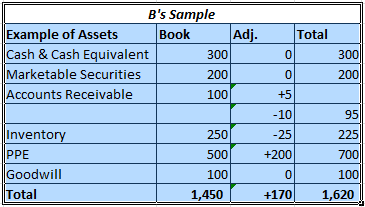Triggered upon comments from couple of fellow bloggers, Musicwhiz, GMGH, Richard and Jason in the previous post, I went to read further on Greenwald’s take on reconstructing the book value using a Reproduction Cost Basis methodology which I will talk in detail in this part 2 series of valuing assets and how when combined with other earnings metrics such as EPV which he favored (which I will talk in part 3 of the sequel later) more than the DCF method, this could become a powerful valuation method.
This will be a rather long post because I will explain each balance sheet item but if you can stay till the end, you probably will think behind the reason for doing so and can help you in your future asset valuation. I certainly learnt a lot just by doing this.
The idea for this type of asset valuation is to figure out how much a competitor would have to spend in order to replicate the company’s business. Unlike Graham’s method where he discounted certain percentage of the assets value in his books, the reproduction cost method requires you to go through each line item of the balance sheet thoroughly to see if they require any adjustment.
This may require you to understand some of the accounting treatment and business moats of the company, but we’ll see where it takes us.

Balance Sheet (Assets)
1.) Cash & Cash Equivalent
These are taken at face value, assuming you are confident that the cash is really available in the books. So no adjustment is required here.
2.) Marketable securities or investment
These assets are marked to their market value so again no adjustment is required here. This is the very same reason why book value for trading companies and banks are more relevant than say biochemical companies.
3.) Accounts Receivable
You need to add a doubtful reserve premium to this category because a competitor will not have the same competency of being able to perform the same level as the original company.
Do also look out on whether the Accounts Receivable have bad debt provision already accounted for when they are reported in the books. Most accounting treatment requires companies to report net of Accounts Receivables (after less off bad debt provision) in their books but for those who has reported separately, do discount the adjustment for the provision. Depending on the company’s risk profile, the provision may look like this.
Overdue Ageing Outstanding
Current – 0%
1-30 days – 2%
31-60 days – 5%
61-90 days – 10%
>90 days – 50%
4.) Inventory
Here, you probably need look at whether you are analyzing US or other Asian companies.
Under IFRS, the LIFO (Last-in-First-out) method for accounting for inventory costs is not allowed, so you can be safe that every companies are using similar accounting treatment. In this case, no adjustment is required.
But if you are analyzing US companies under the US Gaap, some companies may either use LIFO or FIFO method for accounting their inventory. In this regard, you may need to adjust by adding back if the company is restating its accounting treatment from LIFO to FIFO and vice versa.
Do take note also that under IFRS, inventory’s write down can be reversed in future periods while US Gaap prohibits that writeback. In any case, do account for all these matters when you are adjusting for reproduction cost.
5.) PPE (Property, Plant and Equipment)
This is one of the thing I have highlighted in my previous post.
Items on the PPE will need to be depreciated over time. And depending on the types of depreciation method the company has chosen, you may be required to adjust back when restating them to a different depreciation method of accounting. E.g: From Double Accelerating to Straight Line method.
Freehold and Leasehold land would also need to be restated to their latest appraisal market price. This means that you would most likely need to add back since they are recorded at historical costs on the PPE.
Machinery and Equipment is a little tricky as they become obsolete over time. However, if the equipment is specialized, they may have a special salvage value you can adjust for.
6.) Goodwill
Goodwill is harder to estimate as they represent an intangible part of the company that may be most important to the company. Think Pfizer or Coca-Cola.
If you want to be conservative, you can take the value as it is on the books.
 |
| Example of Reproduction Cost Asset |
Balance Sheet (Liabilities + Equities)
On the other side of the equation, we have the liabilities and equities portion to match replicate the assets.
Unlike normal book value computation where we subtract all the total liabilities, the reproduction cost method only require you to deduct certain liabilities such as spontaneous and circumstantial liabilities.
1.) Spontaneous liabilities
Spontaneous liabilities arise from the day to day working capital operations that are not required by the new business. Thus, this amount should be deducted from the reproduction value.
These can be tied to changes in the cost of goods or sales or accounts payable. For example, you can take 10% of cost of goods sold as those not needed by the new business.
2.) Circumstantial liabilities
As the name suggests, these are usually your liabilities circumstances depending on the business you are operating. For example, oil companies usually need to accrue for items such as oil spills or lawsuit and these type of liabilities do not add any value to generating assets, thus they are deducted.
3.) Cash not required to run the business
These are probably conservative cash figure that is deducted for not requiring to run the business. Usually, these are taken at around 1% of sales or cash amount.
Thus putting it all together, we get Reproduction Value at:
Adjusted Asset Value – Spontaneous liabilities – Circumstantial liabilities – Cash not required in business
You can see how this is more intensive than simply computing the book value, which is your NAV of the company you are tracking. As with all valuation method, this only takes into account the balance sheet value, and it probably need to be combined with other earnings metric to get a better overall valuation out there.
I will read up on some of the earnings valuation and share in part 3 series in time to come.
Thanks for reading and let me know your thoughts or comments.


B : This one is a bit too "chim" for me to digest… hahaha. Just curious, in your example table, in the "Account Receivable" rows, why there is "+5" and "-10" adjustments? Are you trying to illustrate separate category of receivables?
Hi Richard
Thanks for your honest feedback.
This does require you to know a few of accounting requirement here and there to make it work best.
In the Accounts Receivable, the first adjustment of +5 is the doubtful reserve premium that needs to be added back on the assumption that the competitor will not be able to replicate the collection competency.
The second adjustment of -10 is the bad debt provision, i.e the amount of bad debt that will not be able to be collected and have to be written off.
Hi B,
This sounds very much related to the Q-ratio! If it costs considerably more to buy a company outright compared to reproducing it from scratch, it usually means it is overvalued.
However, the Q-ratio measures the reproduction cost / book value and isn't a substitute for book value. I believe you are trying to replace book value by a more accurate metric instead of comparing a derivative to itself.
I am looking forward to your earnings valuation posts! A lot of companies are not appropriate to value using P/B, such a retail and services companies, so I am keen to see your views on that.
Hi GMGH
Yes, the Tobin Q-ratio is a concept that divide the market value by the replacement cost of an asset. It has been widely used by economists.
The above replacement cost model is a good example of thinking slightly deeper than the simple book value where everyone can see it at face value. I think they are also more relevant especially when we take in all sorts of adjustment into the model.
I am looking into some of the earnings model that would substantiate this asset model so will share with everyone once I have read them up sufficiently.
Hi B,
I think you've highlighted the challenges well of just taking asset values at 'face' value – many times they won't reflect 'market value'.
Intangible assets are a very tricky one, and are usually one of the biggest assets for the highest quality companies. Unfortunately intangible assets usually only get booked on the balance sheet after acquiring another business and recording it's goodwill – internally generated intangible assets generally cannot be recorded, like the company's own brand, intellectual property, customer relationships etc.
Opportunity cost is also another interesting concept to think about when looking at the reproduction cost approach. While a business is busy reproducing all the assets, it might be missing out on some profits in the meantime, so it might be willing to pay a premium to just buy the assets today.
Posting this material is a great way to learn and share ideas – look forward to your earnings analysis!
Cheers,
Jason
Hi Jason
Thanks for your input and feedback.
Intangible is a very tricky one especially in healthcare industries where patents can expiry or tech industries where they can be overvalued. It's interesting to think about the second derivative of book value in this sense.
I hope to be able to post the earnings analysis that goes well with this. Thanks for the discussion.
Hi B,
Great analysis with regards to reproduction value. Enjoyed the post a lot!
However, not sure whether I understood correctly but for the sake of discussion regarding comparison and valuation purposes – after applying the formula highlighted in the post, it is found that both Company A & B has the same reproduction value, say $10M. However, Company A has an extra $5M of cash not required in the business. From here, assuming all other things remain the same, an unknowing analyst might have concluded that on a security selection basis, both A & B are on equal grounds and because of that, he/she may have missed the (potential) bargain opportunity afforded by the extra $3M of cash in Company A that is actually deducted from the calculations. Am I right in this regard?
Of course, if we follow a strict definition of estimating how much a competitor needs to replicate the business, the reproduction value formula could be of great use. But for comparison purposes in security selection, this formula might not be as telling if we remove the cash not required in business.
To conclude, like what you've already mentioned in your post, the use of reproduction valuation needs to combine with other metrics to get a better overall valuation.
Hi Secretinvestors
Thanks for your comment and welcome to the finance blog community. I've read your post on AP Oil, they are well articulated. Looking forward to seeing you post more on valuation.
The rationale for deducting the cash not required for business is due to the nature of the asset itself which does not "work" to provide future earnings. The idea is that every assets and liabilities have a role to play and deducting this portion of the cash not used is seen as being more conservatively used. Again, it will not be easy to deduce how much is cash that is not being required in the business. Most will take 1% of sales or cash portion which is very minor in any case.
Thanks for your comments and discussion. Hope to see you more in the finance blogosphere.
Hi B,
Thanks for the reply 🙂 Looking forward to your earnings analysis post!